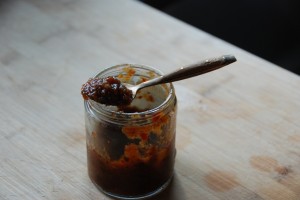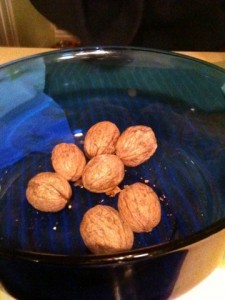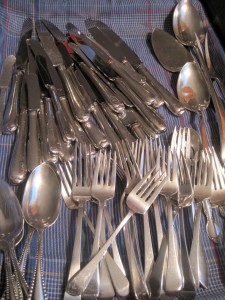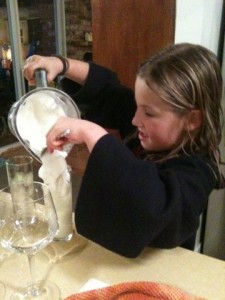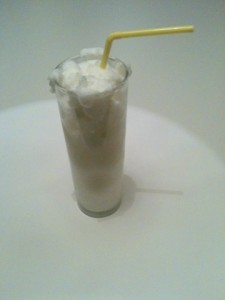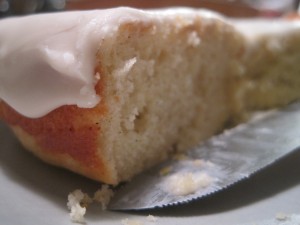by Caroline
I might like to think that my strawberry pop tarts were the hit of our New Year’s Day party, but it’s Tony’s roasted chili paste that friends are still talking about, and while Tony’s made a couple extra batches to give away, somehow we find ourselves opening the jars and digging in before we can make delivery. I don’t usually even like hot sauces or spicy food, but this is so good, I’ve been dunking broccoli spears into it as a snack, spreading it on crackers, wondering at breakfast when I can eat some next. So as a public service (and so our supply will last a little longer), I’m offering the not-so-secret recipe here, which Tony found in Nancie McDermott’s Real Vegetarian Thai, and is also conveniently posted on line. I’m pasting the recipe in, lightly edited, but do click over to the original to enjoy the talk of feisty coals and palm sugar kisses.
The only ingredient that can be tricky to find (and that involves a particularly time-consuming step) is the tamarind for the tamarind liquid. We’re lucky enough to live near loads of Asian markets, but you can find this ingredient online at one of our new favorite websites (check out those cooking videos!) or use freshly-squeezed lime juice sweetened with a bit of molasses.
* 1/2 cup small dried red chilies such as chiles de Arbol, stemmed, halved crosswise, and loosely packed, about 1/2 ounce
* A generous 1/2 cup unpeeled shallots, cut lengthwise into chunks, about 3 ounces
* 1/4 cup unpeeled garlic cloves (8 to 10 large cloves), about 1-1/2 ounces
* 1/2 cup vegetable oil
* 3 tablespoons palm sugar or brown sugar
* 3 tablespoons Tamarind Liquid (recipe below)
* 1 tablespoon soy sauce
* 1 teaspoon salt
In a wok or a small, heavy skillet, dry-fry the chilies over medium-low heat until they darken and become fragrant and brittle, 3 to 5 minutes. Shake the pan and stir frequently as they roast. Remove from the heat and transfer to a plate to cool.
Increase the heat to medium and dry-fry the shallots and garlic, turning them occasionally, until they are softened, wilted, and blistered, about 8 minutes. Remove from the heat and transfer to the plate to cool.
Stem the chilies and shake out and discard most of the seeds. Crumble the chilies into small pieces. Trim the shallots and garlic, discarding the peel and root ends, and chop coarsely. Combine the chilies, shallots, and garlic in a mini processor or blender and pulse to a coarse paste, stopping to scrape down the sides as needed. Add 1/4 cup of the vegetable oil and grind to a fairly smooth paste. Transfer to a small bowl and set aside.
Pour the remaining 1/4 cup oil into the wok or a skillet. Place over medium heat until a bit of the paste added to the pan sizzles at once, about 1 minute. Add the ground chili paste and cook, stirring occasionally, until the paste gradually darkens and releases a rich fragrance, about 5 minutes. Remove from the heat and set aside to cool to room temperature.
Combine the sugar, tamarind, soy sauce, and salt in a small bowl and stir well. Add this mixture to the cooled chili paste and stir to combine. The paste will be quite oily, and must be well stirred before each use. Transfer to a jar, cap tightly, and refrigerate for up to 1 month. Use at room temperature in recipes or as a condiment.
Makes about 1-1/4 cups
Tamarind Liquid
* 1/2 cup tamarind pulp
* 1 cup warm water
Place the tamarind pulp in a small bowl and add the warm water. Let stand for 20 to 30 minutes, poking and mashing occasionally with your fingers or a spoon to break the sticky lump into pieces and help it dissolve.
Pour the tamarind pulp and water through a fine-mesh sieve into another bowl. Use your fingers or the back of a spoon to work the tamarind pulp well, pressing the softened pulp against the sieve to extract as much thick brown liquid as you can. Scrape the outside of the sieve often to capture the thick purée that accumulates there. Discard the pulp, fibers, and seeds that have collected in the sieve and thin the tamarind liquid with water as needed until it is about the consistency of pea soup.
Use as directed in recipes, or seal airtight and refrigerate for up to 3 days. It sours and sharpens as it stands, so if it has stood for several days, taste it and adjust the flavor with some sugar.
Makes About 1 Cup

